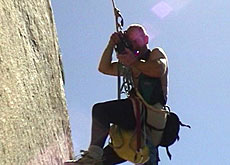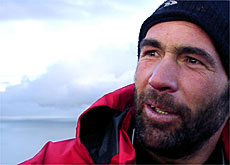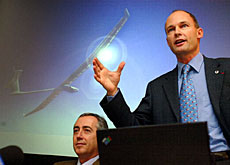Swiss photographer shows taste for adventure

Daredevil Swiss photographer and filmmaker Thomas Ulrich is planning an epic solo journey across the North Pole from Siberia to the coast of Canada.
It will be the first time that anyone has attempted the 1,700 km journey across the frozen Arctic entirely without support.
Ulrich made a name for himself in 1999 when he and his team became the first to scale the west face of the Cerro Torre mountain in Patagonia in winter. His photo reportage was later published in the prestigious National Geographic magazine.
The same year Ulrich accompanied a team of climbers ascending the demanding Eiger north face in Switzerland, who were using the same type of equipment used during the first ascent in 1938. His film scooped two mountain film awards in Canada and Austria.
Ulrich also shot a series for Swiss television based on an expedition to Mount Everest in the Himalayas in 2003.
He is now on tour in Switzerland recounting his adventures with films, slides and a large dose of humour. swissinfo caught up with him between shows in his home town of Interlaken.
swissinfo: How much of a challenge is it taking photos and making films in such harsh conditions?
Thomas Ulrich: It’s a team effort. The other participants know that they are not just there to climb. They also have to work hard to get the pictures and wait for me when I have to change reels. When I see a good picture, it’s an adrenalin rush and I don’t think about having cold fingers.
swissinfo: I guess you have to be extra good at climbing to keep ahead of the team?
T.U.: That’s probably what makes my pictures speak a special language. I’m not only a photographer; I’m also able to climb these mountains. I was a mountaineer for years before I started to do photography. I think it would be a lot harder for a photographer to learn to be a mountaineer.
swissinfo: Which do you find more rewarding, taking photos or shooting films?
T.U.: I like both. In the beginning I thought filmmaking was easier, but now I think it’s more difficult. If you don’t have all the sequences you need for a climbing film, it will fail. But if you lose some photographs in a documentary, it’s easier to still make a good story out of it.
swissinfo: What are the most dangerous situations you’ve experienced in your career so far?
T.U.: It’s hard for me to tell you things like that because all my expeditions went very smoothly. When people come back from expeditions telling stories of how they almost lost their lives, I just think they just didn’t plan well enough. My aim is not to come home and tell people how I almost died. I want to explain what we had to do to make the expedition a success.
If we do an unsupported expedition, we want to do the whole thing taking all our equipment with us. We have to be able to deal with injuries or sickness. For example, my teammate got blood poisoning but we had the right medicine to cure him. If you have problems on an ice cap, you can’t rely on a helicopter or plane to come to your rescue.
swissinfo: You now have a year to organize your North Pole expedition. How difficult will it be to get the sponsorship?
T.U.: I need between SFr250,000 and SFr300,000 ($211,000 and $254,000), an amount I can’t even think about. I think it is far more difficult to find the sponsorship than to do the expedition itself.
swissinfo: How dangerous will the expedition be?
TU: It may sound risky, but I am now planning expeditions that are very hard but less dangerous. If I want to do a documentary in the mountains, it always has to be further, higher and steeper than the one before. We have to risk too much to get a great story. That’s why I am trying to break away from mountaineering and concentrate on exploring.
swissinfo: How fit will you have to be for the North Pole trip?
TU: I will have to be fitter than I have ever been in my life. I have a personal trainer who helps me plan my programme, so that I don’t do too much just before the expedition in March 2006. Almost every day, I will be pulling tyres up hills – it’s the only way to simulate what it’s like to pull a sledge for three months over an ice desert.
swissinfo: How do you cope with being away from your family for such long periods?
TU: I’m definitely not used to it. The hardest day is the day I leave. I stand in the shower, asking myself why I’m going away. But as soon as I get back I feel like leaving again.
When I am home, I spend more time with my family than most Swiss men working regular hours. My wife and children know I plan well for my trips, so they get less apprehensive as they find out more about the places I am going to.
But my older daughters, who are eight and ten, still try and talk me out of it, so that’s quite tough.
swissinfo-interview: Julie Hunt in Interlaken
In 2003, Ulrich and Norwegian Boerge Ousland became the first people to cross the Patagonian icefields unassisted.
The expedition lasted 54 days.
They crossed 100 km water, 450 km of glacial ice and scaled 1,000-metre-high cliffs carrying 280 kg of luggage.
They survived on porridge and reindeer meat.
Swiss explorer, mountaineer, photographer and filmmaker Thomas Ulrich is planning his most daring expedition to date – a lone, unsupported crossing of the North Pole.
He has been on a special fitness regime to prepare, including pulling tyres uphill.
The 1,700 km expedition from Siberia to the Canadian coast is slated for March 2006.

In compliance with the JTI standards
More: SWI swissinfo.ch certified by the Journalism Trust Initiative



You can find an overview of ongoing debates with our journalists here. Please join us!
If you want to start a conversation about a topic raised in this article or want to report factual errors, email us at english@swissinfo.ch.